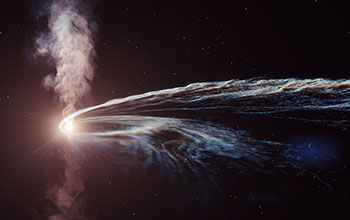Multimedia Gallery
Debris from a star destroyed by supermassive black hole are flung into space
After a supermassive black hole tore a star apart, roughly half of the star's debris was flung out into space, while the remainder formed a glowing accretion disc around the black hole. The system shone brightly across many wavelengths and is thought to have produced energetic, jet-like outflows perpendicular to the accretion disc.
[Research supported by U.S. National Science Foundation grants AST 1454816, AST 1616566, OISE 1545949 and AST 1518052.]
Learn more in the New York University news story Scientists link star-shredding event to origins of universe’s highest-energy particles. (Date of image: unknown; date originally posted to NSF Multimedia Gallery: June 18, 2021)
Credit: DESY, Science Communication Lab
Images and other media in the National Science Foundation Multimedia Gallery are available for use in print and electronic material by NSF employees, members of the media, university staff, teachers and the general public. All media in the gallery are intended for personal, educational and nonprofit/non-commercial use only.
Images credited to the National Science Foundation, a federal agency, are in the public domain. The images were created by employees of the United States Government as part of their official duties or prepared by contractors as "works for hire" for NSF. You may freely use NSF-credited images and, at your discretion, credit NSF with a "Courtesy: National Science Foundation" notation.
Additional information about general usage can be found in Conditions.



